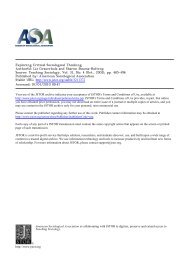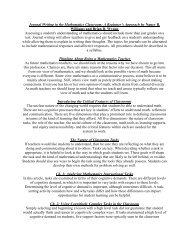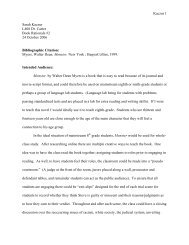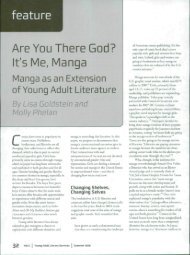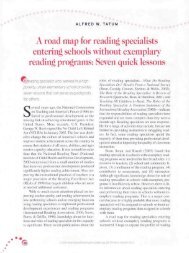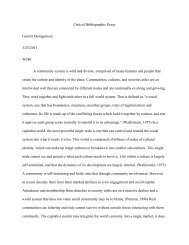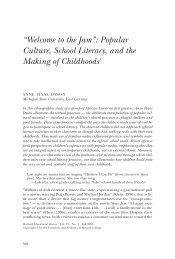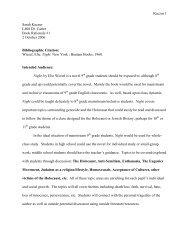Mills (2009) Interogating competing multiliteracy ... - Oncourse
Mills (2009) Interogating competing multiliteracy ... - Oncourse
Mills (2009) Interogating competing multiliteracy ... - Oncourse
Create successful ePaper yourself
Turn your PDF publications into a flip-book with our unique Google optimized e-Paper software.
108 K.A. <strong>Mills</strong><br />
Conversely, there are aspects of Internet discussion threads that essentially remain<br />
regular and stable. For example, when users identify a spelling error in their transmitted text,<br />
a common practice is to immediately forward the corrected spelling, flagged by an asterisk.<br />
Large repertoires of English words used in online discussions have no commonly recognised<br />
abbreviations, and users must draw upon ‘standard’ spelling. New textual designs always<br />
build on existing resources for meaning making, having a degree of familiarity that enables<br />
the formulation of descriptive and analytic categories to describe texts (Cope and Kalantzis<br />
1997).<br />
The multiliteracies argument has awakened literacy educators to recognise that the skills<br />
required to communicate effectively in society are constantly changing. In particular, cultural<br />
differences and a proliferation of communications media give impetus for a pedagogy<br />
of multiliteracies for locally diverse, educational contexts (LoBianco 2000; New London<br />
Group 2000). Interestingly, syllabi across the seven states and territories in Australia, where<br />
this paper is written, address the need for students to design multimodal texts for a variety<br />
of social purposes (ACT Department of Education and Training 2000; Board of Studies<br />
New South Wales 1998; Department of Education and Training Tasmania 2007; Department<br />
of Education and Training Western Australia 2005; Department of Employment Education<br />
and Training Northern Territory 2005; South Australian Department of Education and<br />
Children’s Services 2004; Queensland Studies Authority 2006; Victorian Curriculum and<br />
Assessment Authority 2005).<br />
The semiotic terrain is undeniably changing in fundamental ways, and this transformation<br />
requires the continued revision of metalanguages or new grammars to describe the<br />
burgeoning and hybridised variety of text forms associated with information and multimedia<br />
technologies (New London Group 1996). To continue to teach to a narrow band of<br />
print-based genres, grammars and skills is to ignore the reality of textual practices outside<br />
of schools. Students must be free to engage in new and multimodal textual practices, rather<br />
than simply reproduce a tightly confined set of linguistic conventions.<br />
Multiliteracies pedagogy<br />
Despite the prominence of multiliteracies in international literacy research since the New<br />
London Group’s paper in the Harvard Educational Review (1996), the multiliteracies pedagogy<br />
– the ‘how’ of multiliteracies – has been received with both enthusiasm and reservations.<br />
The New London Group had envisaged that a multiliteracies pedagogy might provide<br />
‘access without children having to erase or leave behind different subjectivities’ and to be<br />
‘genuinely fair in the distribution of opportunity’ (New London Group 2000, 18). The multiliteracies<br />
pedagogy of the New London Group involves four related components: situated<br />
practice, overt instruction, critical framing and transformed practice (New London Group<br />
2000). Situated practice involves building on the lifeworld experiences of students, situating<br />
meaning making in real-world contexts. Overt instruction guides students to use an explicit<br />
metalanguage of design. Critical framing encourages students to interpret the social context<br />
and purpose of designs of meaning. Transformed practice occurs when students transform<br />
existing meanings to design new meanings (New London Group 1996). These components<br />
of the pedagogy do not constitute a linear hierarchy, but may occur simultaneously, randomly<br />
or be ‘related in complex ways . . . each of them repeatedly revisited at different<br />
levels’ (New London Group 2000, 32).<br />
An example of an initially ambivalent response to the multiliteracies pedagogy appears<br />
in a monograph edited by key members of the New London Group, Cope and Kalantzis<br />
(2001). Auerbach (2001) argues that the notion of accommodating four pedagogical



